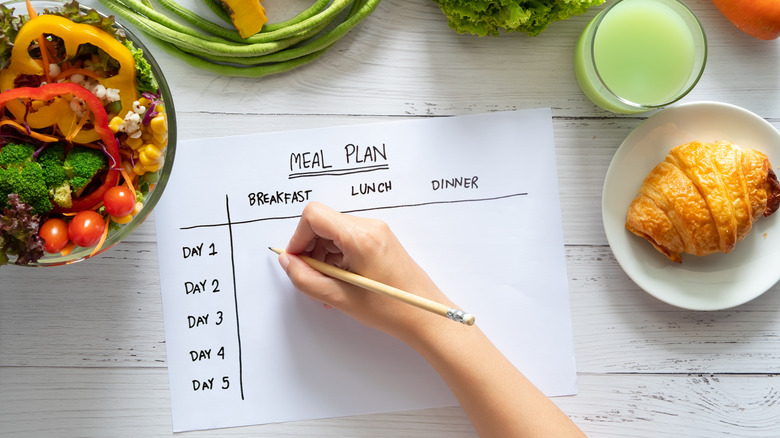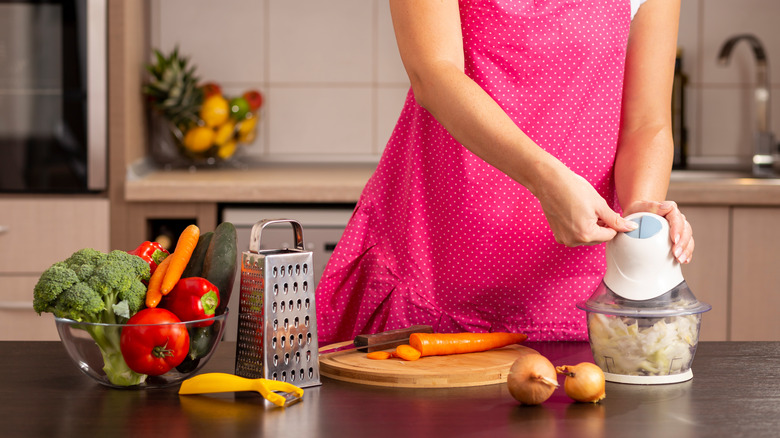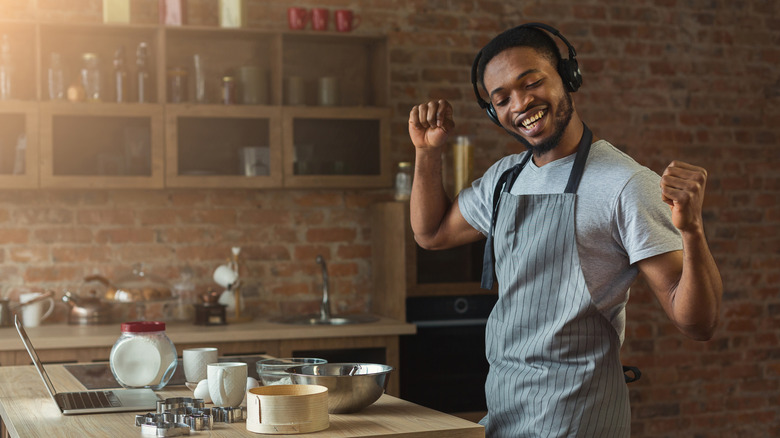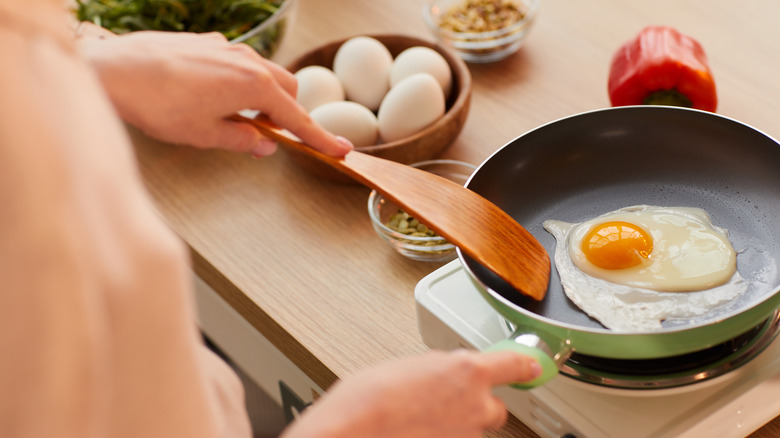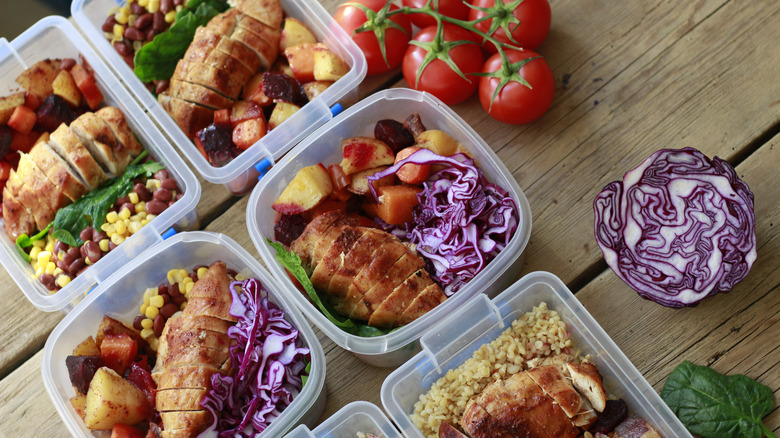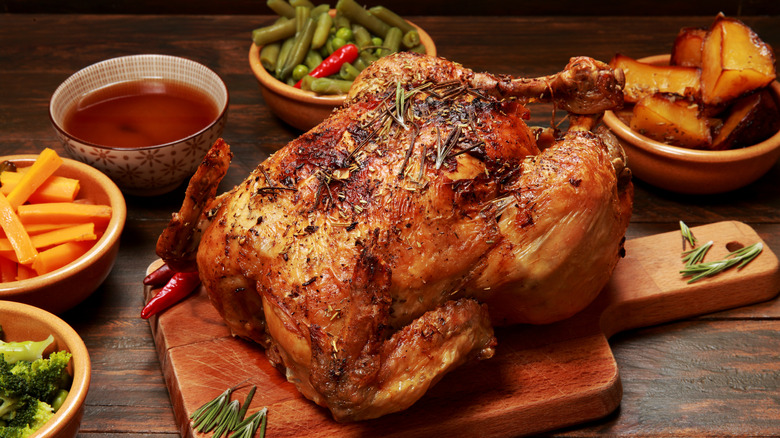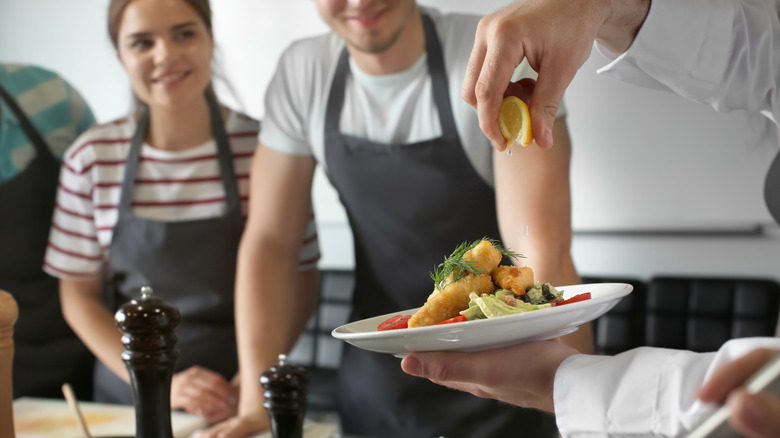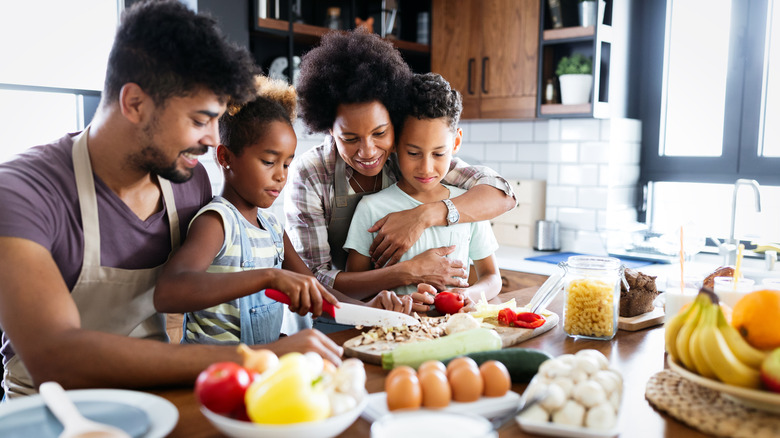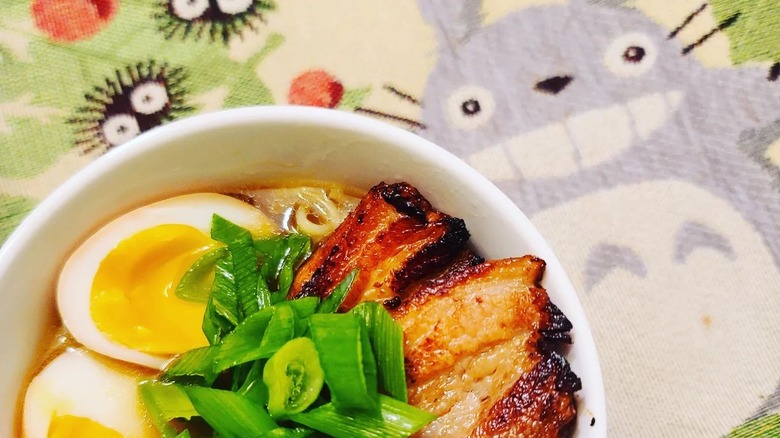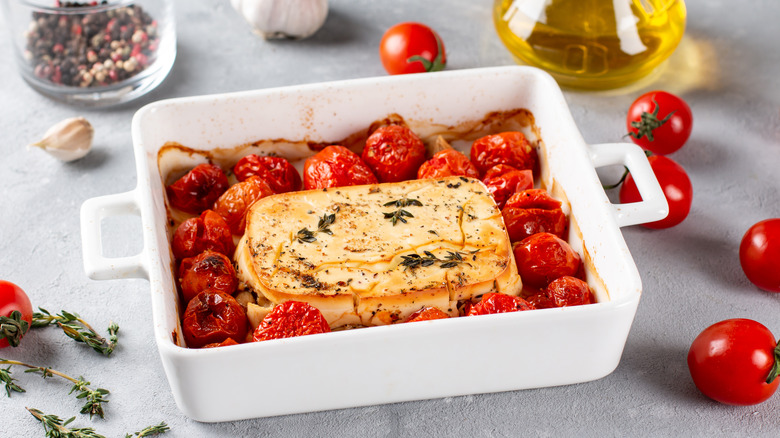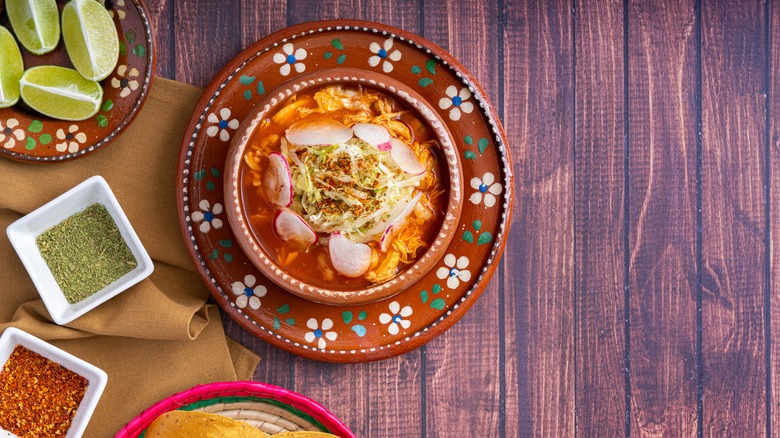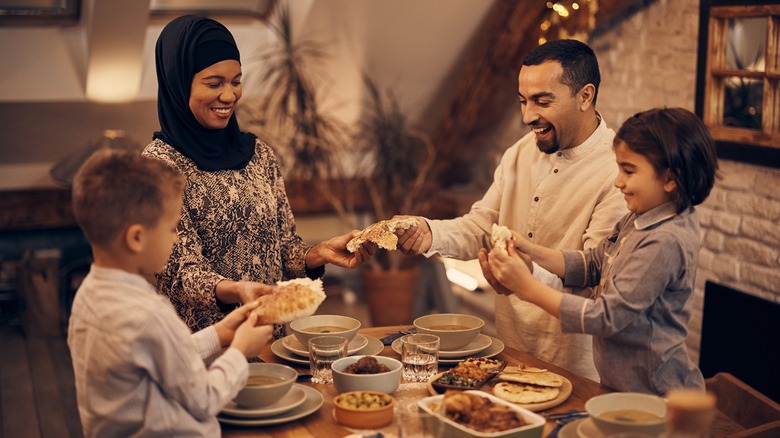14 Fun Tips For People Who Can't Find The Joy In Cooking
Whether you love it or hate it, cooking is a vital life skill and a persistent, everyday task. Some people find the kitchen an inviting space for expressing creativity and relieving stress, while others feel a sense of dread at the thought of firing up the stovetop. Just like any other passion or hobby, not everyone finds joy in the same activities. We can't all be Julia Childs. Some of us find cooking boring, monotonous, messy, time-consuming, stressful, and even intimidating. Trying to find the motivation to feed yourself or your family interesting, tasty, and healthy meals three times a day can definitely be overwhelming for those who are not culinary-inclined.
Despite these deterrents, there are numerous proven benefits associated with cooking at home, even a few times a week. Cooking at home is often healthier, more likely to be eaten mindfully, stimulates the brain, and provides an opportunity to bond with loved ones. Preparing meals at home is also more budget-friendly than dining out. Homemade meals may be better for the environment as well since you can control the ingredients used with less wasted food and packaging. No matter how many benefits it offers, some people still have trouble finding joy in preparing a home-cooked meal. Diminish those feelings of stress or disdain next time you step into the kitchen by trying out these fourteen fun tips for people who can't find the joy in cooking.
Get in the right headspace
Before you begin pulling out those pots and pans, set yourself up for success by checking in with your mindset. Longtime haters of cooking might need to take some time to reframe their thinking and be open to discovering even just one or two aspects of the task that they genuinely enjoy. Perhaps you used to be interested in cooking, but it has become uninspiring, or you have been turned off from the kitchen after a bad experience or recovering from the scars of diet culture. Be gentle with yourself during this undertaking while acknowledging what you dislike about the process and setting all of those things aside in order to ease in with an open mind.
From a myriad of voices telling you what is good or healthy to the barrage of aesthetically perfect plates on social media, food often becomes more than its role as physical sustenance, carrying mental and emotional weight. If the emotional baggage of food and cooking is keeping you away from the kitchen, it might be worth talking to a professional. For more mild feelings of anxiety or lack of motivation for cooking, give yourself a pep talk and stay mindful throughout the process, paying special attention to even small moments of joy, whether it is learning about a new ingredient, hearing the sizzle of food crisping in a skillet, or the satisfaction of a loved one telling you they enjoyed your food.
Plan ahead
Planning ahead is one of the best ways to make cooking feel less chaotic and intimidating by giving you control over what and when you eat. As you think about the meals you would like to prepare, you might also use this planning stage to organize your kitchen in a way that suits your needs. If your cookware is hard to get to or your cutting boards are tucked in the back of a cabinet, you are only giving yourself additional barriers to cooking at home. Removing this friction is one step toward making cooking a less taxing experience. Take a moment to mentally walk through the process and see what other barriers you can remove. Dread going to the grocery store? Try ordering ahead through a shopping app. Don't know what to make? Get the family involved by offering meal ideas or looking for inspiration online.
Whether cooking for just yourself, your partner, or a whole family, planning meals can improve food choices while saving money on your grocery bill. Once you have a few meals you would like to make, write down your grocery list and check the pantry and fridge for ingredients you may already have. Be sure to note any additional tools you might need to prepare the food, such as a paring knife or an oven-safe casserole dish. Feeling organized and knowing you have the tools and ingredients you need can diminish some of the stress of cooking.
Take advantage of helpful tools and shortcuts
Remove more of those barriers to cooking enjoyment by taking advantage of helpful tools and shortcuts such as prepared vegetables or pre-mixed seasoning packets. If you despise chopping onions, go ahead and get the pre-cut ones. If you don't have a lot of cookware or tools, consider investing in a slow cooker or multi-cooker like the Instant Pot that can do a lot of the work for you without tons of extra dishes. While these things can sometimes be more expensive, they can save time and energy. Affordable slow cookers and other kitchen wares can often be found at thrift stores or purchased secondhand from yard sales or resale sites.
You don't really need much to get started when it comes to cooking. Some essential tools you will want to have in your kitchen include a good quality chef's knife, paring knife, and cutting board, as well as a skillet, pot, and sheet pan. You may also want to have some helpful items, such as a spatula, tongs, a vegetable peeler, a whisk, and some measuring cups and spoons. Specialty tools such as vegetable choppers, food processors, and other gadgets can save time and energy in the kitchen by expediting common cooking tasks.
Incorporate some entertainment
Listening to music is a great way to boost your mood and raise the enjoyment level of any activity from cleaning to working out and even cooking. Incorporating entertainment while you prepare meals can enhance your enjoyment of the activity, whether you blast your favorite tunes or turn on an interesting podcast. You might listen to an audiobook or even turn on a TV show while you cook. Just be careful not to get too distracted and end up with nicked fingers or a burnt dish.
Pairing something you enjoy with a necessary task you dislike is a psychology hack called temptation bundling. James Clear, the bestselling author of "Atomic Habits," explains that temptation bundling is often used to build habits by linking an activity you want to do with something you need to do. Over time, the reward becomes associated with the cue, and the habit becomes more attractive. Listening to music while cooking is especially beneficial as it has been shown to reduce stress and stimulate dopamine which boosts our mood. Professional chefs have even been known to use this trick to keep them motivated and energized through a lunch or dinner rush with their own go-to cooking playlists.
Build confidence with simple meals
For those who dread the kitchen due to inexperience or the belief that they can't cook, building confidence by starting with simple meals is a great way to ease into finding the joy in cooking. Psychology Today recommends leaning into your individual learning style as you approach new dishes while acknowledging negative emotions such as frustration or anxiety. Don't rush or overcomplicate meals by trying to achieve the elaborate dishes you've seen on social media. Start building a foundation with easy, satisfying meals that let you practice techniques that can later be applied to more elaborate recipes.
Approachable dishes are low-stakes opportunities to practice knife skills and other techniques while building your confidence in the kitchen. Practice chopping vegetables and balancing seasonings without even turning on the stovetop while making a batch of guacamole to pair with some simple quesadillas. Learn basic skills such as preparing rice or roasting vegetables that you can use as building blocks for a complete, well-rounded meal. Soup is a very forgiving dish for beginner cooks, and mastering how to cook eggs will instantly expand your cooking repertoire.
Cook once a week
Once-a-week meal prep is a great way to make the time you spend in the kitchen more efficient and, potentially, more enjoyable. Planning and preparing meals for the week ahead of time has been associated with consuming a more well-balanced and portioned diet, reducing stress by avoiding decision fatigue and rushed cooking, and saving money by reducing the amount of take-out meals and unplanned grocery trips throughout the week.
Whether you prefer to prepare a variety of ingredients ahead of time to utilize throughout the week or assemble entire meals to eat each day or freeze for later, make sure to avoid common meal prep mistakes by giving yourself some variety, using your time wisely, and managing expectations. Some great ways to elevate your meal prep are choosing the right containers, keeping things interesting with new recipes, and combating boredom by adding fresh ingredients to change up your prepped dishes. Choose the method that works best for you or mix and match each week to suit your goals, schedule, and preferences.
Create meals around one ingredient
Deciding what to cook day after day can easily become an overwhelming and stressful task. With the multitude of cookbooks, online recipes, and groceries available, there are so many options that trying to choose what to make can result in decision fatigue, defaulting to a safe option or avoiding cooking altogether and settling on ordering takeout instead. Simplify the process by focusing on a single ingredient as the inspiration for your meal. Building a meal around an ingredient you are comfortable cooking can also grow your confidence in the kitchen. Using the basic formula of protein, starch, and vegetable, choose one of these components as your starting point for building a complete meal.
If you have mastered roasting vegetables, for example, use that as the first building block, then pair your vegetables with pasta or as part of a hearty grain bowl. You can even pair this concept with meal prep by cooking a whole chicken or braising a roast at the beginning of the week, then using that ingredient to build the rest of your meals. A great way to incorporate this idea into a mix-and-match meal prep system is to create a variety of dishes around just a few prepared components, including bases, proteins, vegetables, sauces, and seasonings for quick, easy, and well-balanced meals to enjoy throughout the week. This method could also be a fun exercise for cooking on a budget or helpful for using up ingredients in the freezer or pantry.
Take a cooking class
Enrolling in a cooking class is a fun way to build confidence and comfort in the kitchen. Being surrounded by others who are passionate about cooking can help those less inspired by the culinary arts to find their own joy in the process. With options for those looking to improve basic kitchen skills to more advanced lessons, cooking classes provide a safe space to learn how to use different tools and ingredients while exploring an interesting technique or cuisine. Knowledgeable instructors are also a great resource for tips on food preservation, menu planning, and other skills.
Choose a cuisine that you love to eat or a technique you would like to practice, such as knife skills, rolling sushi, or preparing fresh pasta when selecting a cooking class. You will have the opportunity to discover different flavor profiles, learn how to use unfamiliar ingredients, and draw inspiration from specially curated menus and professional guidance. Courses are often available in person or online by companies specializing in these events, and they are sometimes even offered in local grocery stores or community centers. Bring a friend, family member, or a date to share the experience and provide extra support throughout the lesson.
Make it social
Surrounding yourself with loved ones is a great way to infuse joy into the cooking process. Getting friends or family involved also allows you to delegate tasks and share the burden of preparing the meal. After all, many hands make light work. Preparing food as a family is a time-honored tradition in many cultures, especially around the holidays. In Mexico, families gather during Christmas time to socialize while sharing the laborious task of making tamales, and many families in Asia celebrate the Lunar New Year by filling and folding hundreds of dumplings together.
However, it doesn't have to be a special occasion to prepare food together. Sharing meals with friends or family on a daily basis is a wonderful opportunity to connect and converse. Preparing meals as a family is highly encouraged by organizations like the Child Development Institute for its many benefits, such as family bonding, developing social skills, and teaching kids valuable life skills and healthy habits. Involving kids in meal planning and cooking not only encourages cognitive development in areas such as spatial awareness, sequencing, and literacy but also provides an opportunity to talk about where food comes from and discuss different cultures through their cuisines. Giving children a sense of agency over what they eat and allowing them to help prepare meals might also encourage picky eaters to try new foods.
Revisit a favorite family recipe
There are few things more comforting or nostalgic than digging into a beloved family dish. Whether it's grandpa's signature casserole or mom's famous cookies, revisiting a favorite family recipe is a way of connecting to loved ones and cherished memories through food. Some recipes may have been passed down through generations, bonding us with our heritage, while others carry their own stories that are often as unique as the people who made them. Preserving family recipes is a way of anchoring to our past and carrying on a legacy that can be shared with future generations.
Take some time to join grandma in the kitchen as she makes her iconic dinner rolls or meatloaf, and shadow your auntie who makes the best chicken soup in town. Connect with your loved ones, sharing stories and time while learning how to make the meals that remind you of your childhood. For many, food is an expression of love, and YouTuber Beryl Shereshewsky reminds us how making these recipes can serve as a way of honoring loved ones who have passed and keeping their memory alive through food.
Recreate food from your favorite movie or tv show
Connect cooking to something you already enjoy by recreating food from your favorite movie, television show, or comic book. Bringing recipes from beloved fictional worlds to life is a great way to inspire creativity and fun in the kitchen. For instance, Studio Ghibli movies have earned their reputation for depicting mouthwatering animated dishes that viewers long to taste, from the decadent cake and pastries in "Kiki's Delivery Service" to the elaborate feast from "Spirited Away."
Pop culture phenomena from "Breaking Bad" and "Downton Abbey" to "Gilmore Girls" and "Game of Thrones" have inspired a wealth of blogs and cookbooks devoted to iconic food moments from these enthralling stories. Revisit food-filled moments and creations from your favorite characters in your own kitchen. Daring cooks can whip up Rachel's accidentally sweet and savory trifle from the iconic series friends or journey to the galaxy's edge with recipes inspired by "Star Wars." Prepare for the zombie apocalypse with Carol's beet and acorn cookies, bite into the Burger of the Day from "Bob's Burgers," and take a culinary journey to Wakanda with recipes channeling the vibrant spirit of Marvel's "Black Panther." From recreating the whimsical dishes of fantastical worlds to transforming animated food into real-world creations, turning to your favorite pop culture food moments is a delightful way to bring joy to the kitchen.
Try out a food trend
Driven by innovative professional chefs, the cultural conversations surrounding food, and of course, Tik Tok influencers, the dynamic cycle of food trends can be a fascinating source of culinary inspiration and bring some fun and creativity to the kitchen. From whipped coffee to feta pasta, social media platforms such as Tik Tok have spurred new food trends from bizarre to delicious. Pancake cereal, cloud bread, pesto eggs, and folded tortilla sandwiches are all Tik Tok trends that have had their viral moment inspiring home cooks to give these inventive creations a try.
Outside of the world of social media, food and beverage trends on the horizon might include sustainable alternatives to conventional staples, highlighting traditionally underrepresented cuisines, and incorporating nutritious ingredients that offer both flavor and function. For inspiration, find a food trend that speaks to you and give it a try in your own kitchen.
Draw inspiration from international cuisines
We can learn a lot about other cultures through food. Exploring different cuisines can teach us about the cultural identity and history of a people by offering a unique perspective through traditional dishes, techniques, and flavor profiles. Try dedicating a night or two each week to international cooking styles to expand your palate and bring new life to the usual meal rotation. Exchange Taco Tuesday for Mexican Mondays and research authentic recipes beyond the usual Americanized burritos and quesadillas. You might recreate traditional dishes from your own heritage or sample diverse global cuisines from Africa or Eastern Europe to the Caribbean or Southeast Asia.
The world is full of exciting and delicious food, with each dish telling a unique story that shines a light on a region and its people. Theming of your meals to certain cooking styles allows you to grow your culinary repertoire and cultural understanding by learning and appreciating new techniques, ingredients, and flavor profiles.
Start new traditions
Infuse joy into your cooking experience by creating new traditions with loved ones. Whether you begin a new daily ritual for family dinner or incorporate a special activity for the holidays, building traditions around food can bring joy to your cooking. Reinvigorating mealtime rituals can offer both structure and excitement with a balance of old and new routines. USDA's MyPlate suggests activities and tips for building family mealtime traditions, such as growing a family garden, letting the kids take the lead on trying new foods, or sharing one memorable moment from each person's day.
Find the traditions that benefit you as an individual, as a couple, or as a family by creating rituals completely unique to you or exploring mealtime traditions from around the world. Some great suggestions drawn from other cultures include setting aside the electronics and being present with family while eating as is custom in Jewish households on the Sabbath or savoring a lengthy communal meal in the style of the French. Considering the aspects of mealtime you cherish can help you find your own sense of joy in cooking.


